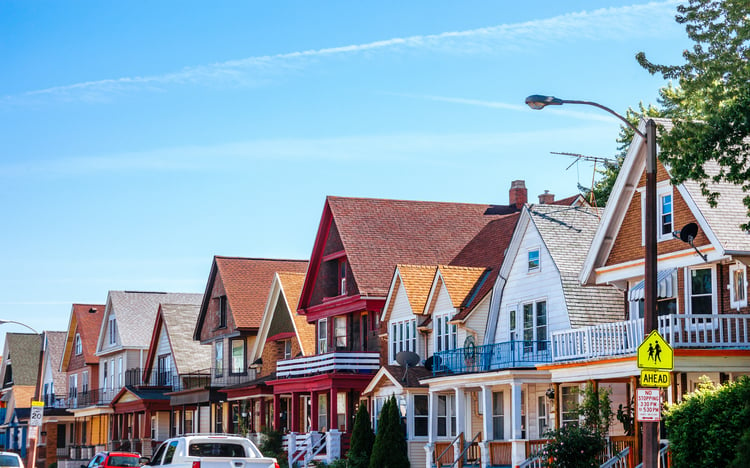All markets move in cycles and real estate is no exception. While no one has a crystal ball, many real estate researchers believe that the real estate market will continue to grow, although perhaps at a slightly slower pace.
Here’s what several outlets have to say about the top real estate market trends for 2022 and beyond.
Trend #1: It seems unlikely that the housing market will crash in 2022
Let’s begin with the million dollar question.
By nearly every metric, the housing market has been performing exceptionally well, especially for real estate investors. Home prices are surging, interest rates are low, and good homes are difficult to find in some markets.
As many people have observed, those are the same conditions the housing market had 15 years ago, just before the housing bubble burst and the Great Recession began. Back then, nine million families lost their homes as housing prices plummeted by 30%.
So is the housing market heading for another crash?
According to Bankrate, while industry experts say that price appreciation is “worrisome” and rapid price appreciation isn’t sustainable over the long term, there are 6 reasons why it’s not likely the housing market will experience a crash similar to that of the Great Recession:
- Inventories are at record lows, leaving buyers with no other choice than to bid up prices, while the supply-and-demand equation won’t allow a price crash in the near future;
- Builders can’t build quickly enough to meet demand, meaning that the overbuilding that occurred 15 years ago is unlikely;
- Mortgage rates will remain near historic lows in 2022, although they are expected to rise slightly by the end of the year;
- Demographic trends are creating new buyers, with Millennials in their prime homebuying years and Hispanics a young and growing demographic keen on owning a home;
- Lending standards are still relatively strict compared to the Great Recession, reducing the risk that “liar loans” with no documented income can be used to artificially bid up homes prices;
- Foreclosure activity is low because lender’s haven’t been filing default notices during the pandemic, although foreclosures may begin to rise as the year progresses.

Trend #2: Mortgage rates are holding steady
Low mortgage interest rates are one reason the performance of the housing market has been so strong.
Mortgage interest rates are projected to slightly increase from the current rate to 3.500% by the end of the year.But according to mortgage professionals interviewed by The Mortgage Reports, rates are unlikely to change drastically or quickly.
Although the Federal Reserve has announced it would begin to taper its purchases of mortgage securities, mortgage rates can not increase dramatically in the current fiscal environment. Even if rates on a 30-year fixed rate mortgage increase to between 3.75% and 4.25% by the end of 2022, mortgage interest rates will still be at historically low levels.
Trend #3: Home prices continue rising
Over the past five years, the median home sales price has increased by over 33%, according to the Federal Reserve. There is still more buyer demand for homes than there is supply, especially from real estate investors and people looking for larger suburban properties now that working from home is becoming a permanent employment feature.
As Realtor.com predicts in its 2022 Housing Market Forecast and Predictions report, home prices will continue to set records, but will advance at a more moderate pace. Economic growth is expected to sustain buyer purchasing power, with median home sales prices rising by 2.9% in 2022.
Although price increases are beginning to slow, homes are still selling at record speeds. The national inventory of active listings has declined by nearly 56% compared to 2019, which means there are less than half the number of homes to choose from as there was two years ago. As a result, prices are still rising because inventory remains constrained.
The most recent Monthly Housing Market Trends Report from Realtor.com reveals:
- Active listings declined by 26.0% over last year
- Total inventory of unsold homes declined by 16.2%
- Although newly listed homes on the market are down 0.7% nationally year-over-year, sellers are still listing at rates lower than previous years
- Median listing price for active listings was $379,000, representing an asking price increase of 8.6% compared to last year and 22.4% compared to 2019
Trend #4: It’s a seller’s market
The strong demand from buyers combined with fewer homes for sale will continue to create a seller’s market in most housing markets across the country. According to a National Association of Home Builders survey cited by NerdWallet, being outbid is the main reason people are unable to buy a home.
The 2022 Housing Market Forecast and Predictions report from Realtor.com notes that sellers will be in a good position next year:
- Even though some markets may have more for-sale inventory, well-priced homes in good condition will continue to sell quickly in many markets.
- Sellers who have owned for a while have a healthy amount of equity, meaning they will walk away with a significant amount of cash.
- Owners who don’t need to buy another home – such as real estate investors – may be most poised to take advantage of rising housing prices in 2022.
- Sellers explore all options and tools for selling a home, including real estate agents or online marketplaces to gain more exposure and a high selling price.
Trend #5: The housing supply deficit has been increasing
The most recent building permits survey from the U.S. Census Bureau (November 2021) reports that building permits, housing starts, and housing completions have been gradually increasing over the past five years.For example, in October of this year, 1.65 million permits were issued and over 1.24 million housing units were completed.
Despite those impressive housing construction numbers, the housing deficit continues to increase.
According to How Many Starter Homes Are Being Built in Your State by Freddie Mac, the inventory of new and existing homes for sale in the U.S. is at an historical low. As Freddie’s chief economist notes, the main driver of the housing shortage is the lack of entry-level, single-family homes that first-time buyers can afford. In 2019, only 7% of homes constructed were entry-level, down from 40% in 1980.
Freddie Mac does not expect housing demand to decrease near-term, for a variety of reasons including the large number of millennials entering the housing market and the combination of low supply and high demand.

Trend #6: People are moving away from urban areas
Freddie Mac also notes that rural home purchases outpaced urban purchases through the last decade, a trend that is likely to continue. The pandemic has increased interest in homeowner mobility, with a growing number of people moving away from urban areas towards larger homes that are more favorable for remote working and virtual learning.
More and more people are moving to suburbs and rural towns, continuing a trend that began well before anyone heard the word “Covid-19.” Real estate investors may be interested to note that some of the movement is to rural areas within larger metro areas. According to Freddie, this suggests that while people are leaving big cities, many still want to live close enough to take advantage of the amenities that cities offer.
Trend #7: More Inventory Could Be Coming, But it Could Be Slow
As Real Trends reports, many homeowners who might have sold last year chose not to, especially if they owned a home with enough space for remote working and virtual schooling. But as the economy continues to recover and vaccinations are rolled out, more sellers may begin listing their homes for sale this year.
In fact, Realtor Magazine predicts a 6.6% increase in housing inventory in 2022, which may result in multiple offers easing and home prices rising at a slower pace. However, even though more homes may be coming to market, sellers are still expected to have the upper hand. Zillow notes that last year the typical value of a middle price tier home increased by 19.2%, and forecasts that home values will grow by another 13.6% over the next year.
Although more homes may be listed for sale, the net effect on available inventory is expected to be minimal. According to the 2022 Real Estate Market Forecast by RISMedia, even as more sellers enter the market, buyer competition will remain fierce, leading to another whirlwind year of home buying in 2022.
Trend #8: Competition Amongst Buyers Remains Strong
Despite rising home prices and a shortage of inventory, U.S. News also expects that the competition between homebuyers will remain strong. Interest rates are expected to remain at historic lows, and the continued formation of new households is creating the demand for more space.
According to the most recent Home Buyers and Sellers Generational Trends Report by the National Association of REALTORS (NAR):
- 47% of home buyers are between the ages of 31 to 55 years
- Median household income of home buyers is $96,500
- 62% of all home buyers are a married couple
- 67% of buyers have no children under the age of 18 residing in the household
- Home buyers are well educated, with 69% of home buyers holding a bachelor’s degree or higher
- 81% of all buyers purchased a single-family home
- Homes located in a suburb/subdivision were purchased by 50% of all buyers, with 22% buying a house in a small town
- Quality of neighborhood, convenience to job, and overall housing affordability are the top three factors influencing neighborhood choice
- 99% of all home buyers paid the seller’s asking price when purchasing a home
- 66% of sellers did not reduce their asking price before accepting an offer
- Homes were on the market a median of 3 weeks before being sold
Trend #9: The Rental Market is Shifting
There are several rental market trends that landlords should know about in 2022, according to Forbes and Apartmentguide:
Renter demand is changing
With more people working from home, tenants have more options of where to live. A growing number of renters are opting for areas where homes are larger and more affordable.
While expensive urban areas continue to suffer, small and mid-sized cities are seeing a boom in rental demand, with vacant homes rented within days of being listed and rents rising by double-digits in some smaller cities.
Rent inflation is here to stay until 2023
Apartmentguide reports that year-over-year rent prices are up by double digits across the country, and will likely stay that way over the next 2 years. According to economists at the Federal Reserve Bank of Dallas, rent inflation is projected to increase to almost 7% by the end of 2023, the highest it’s been in more than 30 years.
At the same time, home prices are rising faster than incomes, with the price to rent ratio at its highest level since 2006. In effect, the price to rent ratio indicates the potential demand for rental property. The higher the ratio is, the better potential demand there could be for rental property investments.
As home prices keep going up, many would-be buyers are finding it takes much longer to save money for a down payment and closing costs. Homebuyers that are potentially left behind as the price of entry to homeownership increases are renting for longer than expected, helping to keep rental occupancy levels high.
Landlords are using more technology
Forbes notes that more landlords are incorporating technology throughout all parts of their rental property business. Solutions such as online tenant applications and electronic document signers, online rent collection tools, and accounting software are being used to improve the tenant experience and improve profitability.
Because of the pandemic, prospective tenants are also conducting more searches online and looking at fewer properties before they move. Listings that include detailed floor plans, videos, and 3D tours attract more attention from renters.
Trend #10: Foreclosure Activity is Increasing
A recent report from ATTOM Data Solutionsreveals that foreclosure activity continues to increase nationwide. While residential foreclosures were down last year due to lockdowns and moratoriums, foreclosure filings are on the rise:
- Default notices, scheduled auctions, and bank repossessions were up 5% in October 2021 and 76% from a year ago.
- Lender repossessions increased 13% in October 2021 and by 17% over the same time period last year.
- States with the highest foreclosure rates are Florida, Illinois, and New Jersey.
- Major metro areas with the highest nationwide foreclosure rates include St. Louis, Trenton, Miami, Chicago, and Cleveland.
- States with the greatest monthly increase in foreclosure starts in October 2021 include Pennsylvania, North Carolina, New Jersey, Connecticut, and Massachusetts.









